Throughout history, wood has been a favored building material largely because it’s easily worked and in plentiful supply. Yet, the consistent problem faced by centuries of woodworkers is how to prevent the timber from degrading. As wood is organic, it will warp, shrink, swell, and rot when exposed to moisture.
The market is full of products that claim to slow or prevent wood from degrading. Known by the generic name of ‘wood sealer’, these products prevent water ingress through several methods we’ll discuss shortly. A wood sealer can be one of several products such as proprietary chemical sealers, polyurethane, hardening oils, and some stains. Let’s look at the various types of sealer you can buy.
Different Forms Of Wood Sealers
Before selecting an exterior wood sealer, it’s important to understand the different methods used to protect wood from moisture. Despite all the claims by manufacturers, there are three main protection methods:
- Form a waterproof surface film
- Partially block the capillaries of porous material
- A combination of points 1 and 2
Form A Waterproof Surface Film
These products effectively wrap the wood in its own raincoat, preventing moisture from reaching the wood. It’s a sound idea, and it’s how polyurethanes and varnishes work. While these products seep into the wood a little, this method’s effectiveness depends on the surface film’s integrity. If it becomes compromised, water will get in, and mold, mildew, and rot can begin.
With these products, it’s a good idea to inspect them for condition and reapply if you see deterioration, although some products can survive for ten years. As wood can expand and contract with temperature changes, most formulations on the market include products such as oil to allow some flexibility to the surface film while helping nourish the wood. It also helps protect against scratches.
Block Capillaries Of Porous Material
Many products on the market today use silane, siloxane, or silicone as the active waterproofing ingredient. These products all have relatively small molecular structures capable of penetrating a porous surface’s gaps and capillaries and fully or partially blocking them. This partial blocking prevents the relatively large water molecules from entering yet allows smaller water vapor molecules within the timber to evaporate. The marketers call this a ‘breathable membrane.’
Silane has the smallest molecular structure and penetrates the deepest, which marketing-speak calls nano-technology; siloxane is slightly larger, and silicone is larger again and largely bonds on the surface. This size difference between the three explains why manufacturers use a combination in their products, enabling them to claim the ability to waterproof products with vastly different porosity, such as wood, concrete, and masonry.
Silane and siloxane are prone to wear and attack by salts, acid rain, corrosive airborne particles, and ultraviolet light, reducing their lifespan to a few years in most cases. Silicone is more resistant to deterioration and lasts longer, although it doesn’t penetrate as far.
Combining Capillary Blocking And Surface Protection
Every solution to a problem has advantages and disadvantages. We’ve seen how surface films depend heavily on the film’s integrity to maintain waterproofing effectively and that capillary blockers degrade rapidly from light, salts, and corrosive particles. It seems an obvious solution to combine the two and get the advantages of each while offsetting their disadvantages.
Today, products on the market do just that, allowing the capillary blocking products to do their work before sealing the surface with a waterproof film. If the surface film becomes compromised, the capillary blockers don’t allow the water molecules to enter. While it sounds like the perfect solution, your choice of waterproofing depends largely on what you’re trying to achieve, your application, and the timber to which your chosen product is applied.
Suppose the wood is naturally rot-resistant such as oak, and you’d like to retain the natural wood surface. In that case, a capillary blocker might be the answer, allowing the wood to breathe still, but keeping out water to ensure the longevity and look of your project. If the wood has been stained and is in a high-traffic area, polyurethane might suit better given its resistance to scuffing and scratching and the protection it gives the stain. As in all things, you need to make an informed decision.
Hardening Oils, Spar Urethanes, and Stains?
There are a few products that defy perfect classification. Tung oil is a natural oil made from the Tung tree’s nut, one of several hardening oils, with linseed, walnut, poppy seed, and perilla oils some other common choices. These oils seep into the wood, crosslink with oxygen, autoxidize, and harden.
They work similarly to the silanes and siloxanes previously described by partially blocking wood capillaries to prevent water ingress. Yet I would describe these products more as water-resisting than waterproofing. They allow you to wipe up any spillage without lasting damage to the wood, but I wouldn’t be putting wood treated with Tung oil out in the weather and expect it to last a long time.
Spar urethane is a hybrid product worth discussing. It’s usually a mixture of oil-modified polyurethane, tung oil, and UV blockers. It’s a product designed for use in harsh marine environments, with an oil-modified polyurethane to give flexibility to the surface film, preventing it from cracking through movement, swelling, and heat. The Tung oil nourishes the timber, partially blocks the timber’s capillaries, and gives the wood that classic dark tone. The UV blockers increase the product’s life by slowing deterioration from UV rays. You might think it’s the perfect answer, and it is excellent, but it’s also very expensive and darkens the wood. If you can afford it and like the finish, it’d be my choice in very harsh climates.
You’ll often see stains advertised as stain-sealers, and some stains have a natural sealing ability based on their formulation. However, the primary purpose of a stain is to change the color of the underlying wood. If you wish to colorize and seal your project, use a stain-sealer designed for the purpose, or apply polyurethane over the top.
Applying Wood Sealers for Best Results
Regardless of the product, the preparation for application is much the same. While you should always follow the manufacturer’s instructions, here are the steps that usually apply:
- If you apply the product to new wood, sand using no finer than 220-grit sandpaper. Do not use steel wool. Vacuum the sanding dust.
- If there are old finishes but in good condition, remove all traces of wax, grease, and dirt. You can use denatured alcohol and water, bleach and water, or simply warm soapy water. Once dry, sand lightly in the direction of the grain to remove any sheen and to provide a keying surface. Vacuum any dust.
- If there are clear finishes in poor condition, remove them completely, sand, and vacuum the dust.
- Ensure the surface is completely dry before application.
- Stir the product thoroughly but gently, being careful not to shake it.
- Refer to the manufacturer’s instructions regarding the correct applicator; some products require synthetic brushes, and others natural bristle brushes.
- Apply the product in thin coats in the direction of the grain, being careful not to overbrush. Observe the recommended recoat times. Most products will need 2 to 3 coats for maximum protection.
- Be aware of the cure time for those products containing drying oils or oil-based polyurethanes. Until that time is past, be moderate in your use of the surface. Once cured, the maximum traffic can be applied.
Wood Sealers Category Top Picks – April 2024
| Category and Product | Summary |
|---|---|
 Best Sealer – Thompson’s WaterSeal Waterproofing Wood Sealer | This product by Thompson’s has great features. It seals and waterproofs by forming a protective surface film, cleans up in water, dries in 2 to 4 hours, and offers a range of transparency for color depth. |
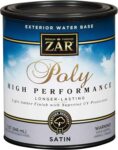 Best Polyurethane – ZAR Poly High Performance | We’ve chosen the ZAR product because it’s a tried and true product that’s tough, flexible, easy to apply, and cheap. Remember, this product will darken your wood slightly slightly. Yet, if you’re not fussed with a rich tone to your timber and you like the benefits a water-based polyurethane brings, this product’s the bomb. |
 Best Capillary Blocker – Olympic Stain Smartguard Multi-Surface Sealant | We like the Olympic Stain Smartguard product as it’s cheap and easy to apply, particularly for decks. It can be applied over damp wood, doesn’t get slippery after application, and doesn’t change the color of your wood. Having to mix it with water is a minor inconvenience. |
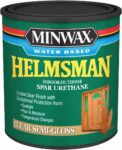 Best Spar Urethane – Minwax Helmsman Indoor/Outdoor Spar Urethane | This oil-modified spar urethane by Minwax is an outstanding product that users love. It’s price-competitive, has great water resistance, and adds a lovely glow to wood. I’ve used this product, and it’s easy to use and dries fast. Highly recommended! |
Wood Sealers Reviews – 12 Best Products on the Market
We’ve reviewed twelve different exterior wood sealers to understand their specific applications, advantages and disadvantages, and gain feedback from users. We aim to give you the knowledge you need to select the most suitable sealer for your next project.
Rust-Oleum Ultimate Spar Urethane
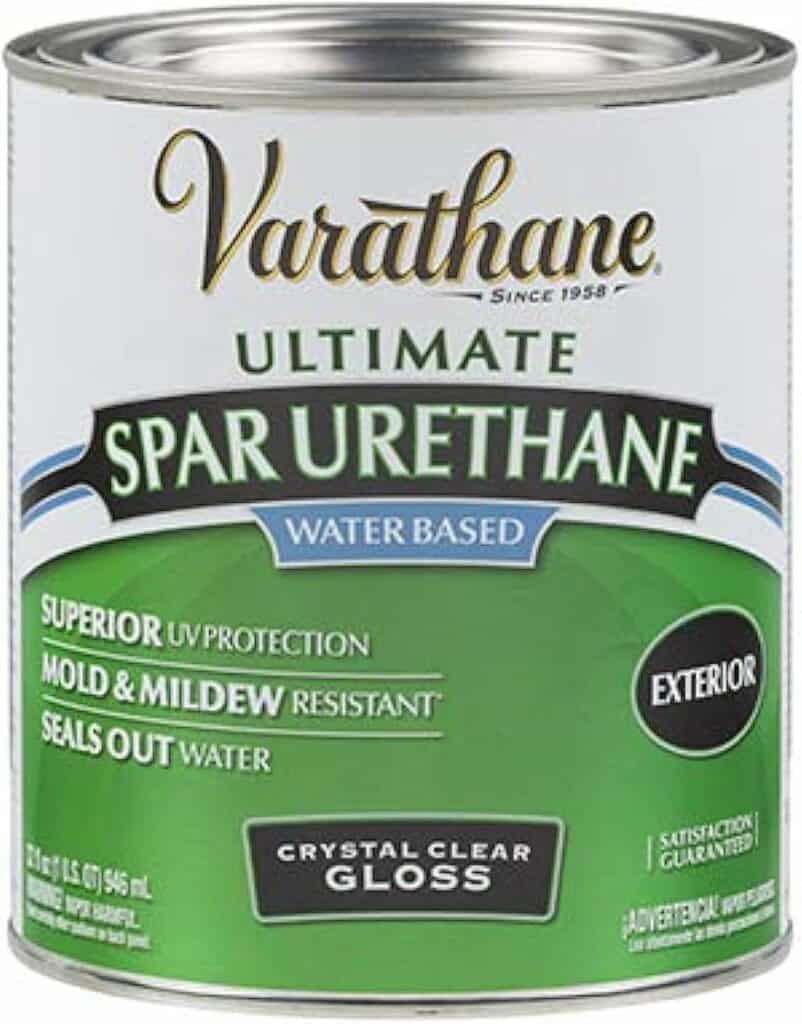
Rust-Oleum manufactures this spar urethane designed to be applied to exterior wood to give a durable, water-resistant, UV-blocking finish. They keep the ingredients a closely guarded secret, but it’s water-based, dries quickly, and crystal clear, so you won’t get the yellowing that occurs with many polyurethanes. It has additives to protect against mold, but best of all, it’s a soap and water clean-up. It’s quite thin, being water-based, so you’ll need a minimum of four coats. It gets high ratings from users who praise its quality, clarity, and ease of use, and it helps that it’s cheaper than many of its competitors.
Pros
- Dries rapidly
- Water-based
- Great water resistance
- Designed for harsh UV environments
- Good scratch and impact resistance
- Rave reviews from users
Cons
- No details on ingredients
- Like most urethanes, if applied over white paint, you may get discoloring
Eco Advance Wood Siloxane Waterproofer
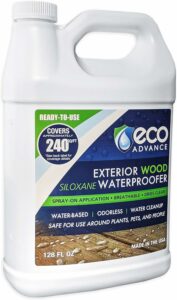
This wood waterproofer can be bought as a concentrate or in a ready-to-use pack, as shown. The safety data sheet mentions the active ingredient is silicone. You apply it with either a brush, roller, or sprayer, and it dries within one to two hours. It’s designed for exterior wood, particularly decks, fencing, wood shingles, and plywood; it’s also safe for the environment and pets, cleaned up with water and soap. You don’t get UV blockers or oils with this sealer, although it’s claimed to resist mold and mildew. It’s a simple and cheap product that protects against water, oils, and stains.
Pros
- Cheap
- Easy to apply
- Environmentally friendly
- Users give positive reviews
Cons
Some poor reviews, although this could be due to application methods used
Rust-Oleum Clear 902 Wolman Classic Wood Preservative
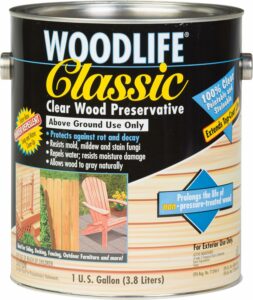
Users praise Rust-Oleum Clear 902 Wolman Classic Wood Preservative; it lasts well, prevents mold growth, and is easy to apply. Milky and thin when straight out of the can, it dries clear within one hour and can be handled. It will need six to twelve hours before full use and 24 hours before a primer or topcoat is applied. Be careful to use personal protective equipment when applying this product as it is a possible carcinogen and skin sensitizer and can cause eye irritation. It cleans up in warm soapy water and, when dry, can be removed with mineral spirits.
Pros
- Allows wood to gray naturally
- Contains a fungicidal preservative to prevent mold and rot
- You can use it under oil-based primer before painting or staining
- Middle-of-the-road price
- Water-based formula
- Touch dry in one hour – can be walked on in six to twelve hours
- Five-star reviews by users
Cons
- Possible toxicity
- It could cause an allergic reaction in sensitive people
- Strong smell during application
General Finishes Exterior 450 Water-Based Topcoat
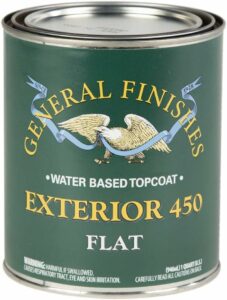
This General Finishes product is interesting, as it’s a water-based, clear-drying topcoat for exterior use. It’s designed to be used on vertical surfaces only and shouldn’t be used over white paints as they may yellow. However, it contains UV blockers and possesses anti-fungal properties. While the manufacturer suggests applying this by spray, it can be applied using a synthetic or foam brush or roller, liberally applying 2 to 3 coats.
Pros
- Contains mold inhibitors and UV protection
- Soap and water cleanup
- Touch dry in 30 minutes and 2 hour recoat time
Cons
- Can’t be used where water may pool or on decks
Minwax Helmsman Indoor/Outdoor Spar Urethane
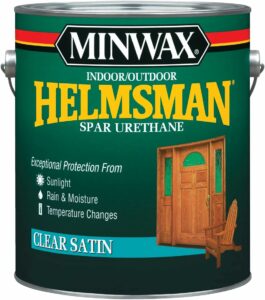
Minwax is a well-known brand offering a good range of high-quality products, with this spar urethane designed for exterior surfaces, although you can use it inside. It contains UV blockers to protect the timber from graying and fading, and oil is included to give the coating flexibility and prevent it from cracking during temperature changes. However, the technical data sheet specifically mentions not using the product on large exterior surfaces such as decks and sidings, where maintenance is difficult. Given that’s where most people would use such a product, it seems a little strange. However, the price is competitive, even if you select the VOC-compliant product, which costs 50% more. It can be recoated in four hours and used normally in 24 hours.
Pros
- Resists cracking due to oil modification
- Great water resistance
- Long-lasting – will survive for five to seven years before reapplication
Cons
- Adds a light amber color to light woods
- Requires mineral spirits for cleanup
- Shouldn’t be used on decks or sidings
Ready Seal Exterior Stain and Sealer For Wood
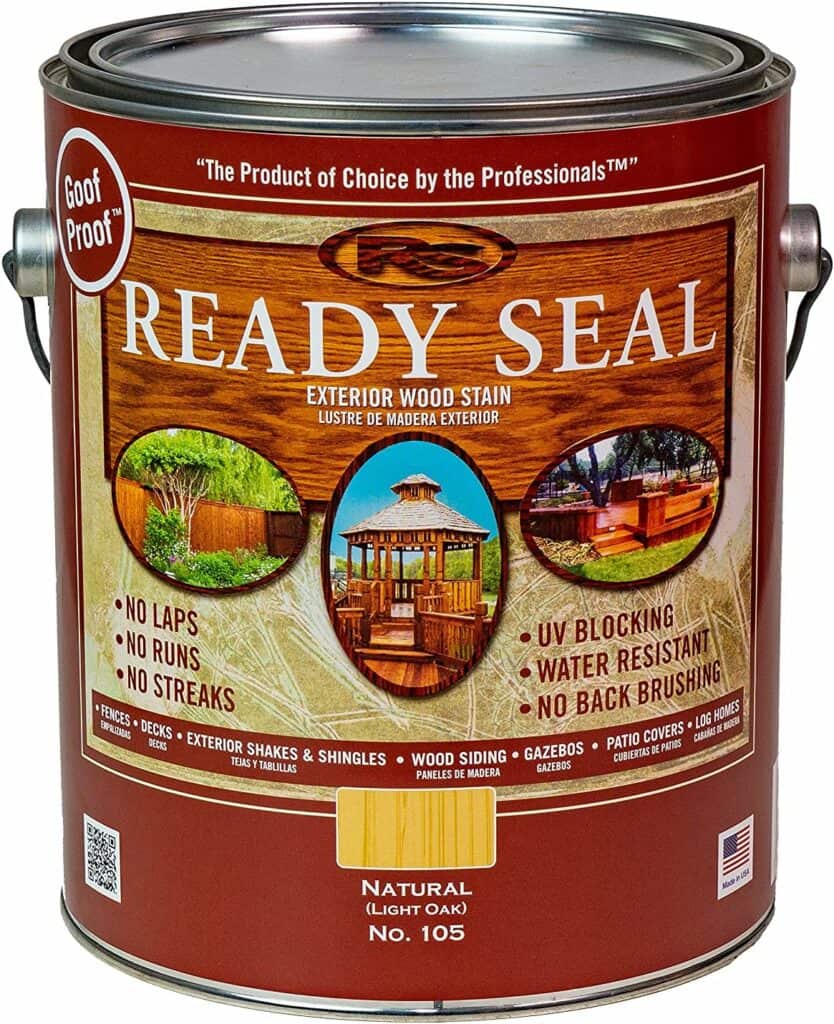
Ready Seal exterior stain and sealer comprises an oil-based semi-transparent stain and resins for water resistance. Designed purely for exterior use, it’s one of the few exterior sealers we’ve looked at that doesn’t preclude application to decks and flooring. Users comment on its easy application and reasonable price. The semi-transparent stain still allows the woodgrain to show through, with a choice of eight colors. Applied by brush, roller, or sprayer, the manufacturer suggests two coats, allowing 45 minutes between each. The technical data sheet claims 2 to 5 years of life expectancy on vertical surfaces and 1 to 3 on horizontal surfaces. The oil-based product is not great for the environment, but it has a reasonably low VOC content, meeting all Federal and State requirements.
Pros
- Reasonably priced
- Shows the natural character of timber
- Is water-resistant
- Easy to apply
Cons
Reviewers claim the colors are darker than suggested
RAIN GUARD Micro-Seal Silane Siloxane Water Repellent Sealer
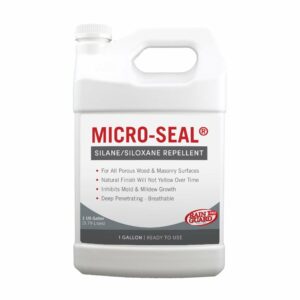
Micro-seal is a product designed to be sprayed onto either wood, masonry, or concrete, where it penetrates the surface and forms a water-repellent emulsion that prevents moisture transfer. You can use it on its own or as a primer underneath paint. The manufacturers claim that the proprietary product is unaffected by weathering, salt, dirt, UV, and wind-driven rain. While full chemical cure of the product takes seven days, you can use the sprayed area 60 minutes after application. It does not yellow, is VOC compliant, and inhibits mold and mildew growth. It also offers some graffiti protection if two coats are used.
Pros
- Used by professionals
- Cleans up with soap and water
- Low odor and no VOCs
- Safe around people, pets, and plants
- Highly regarded by most users
- Not expensive
Cons
Won’t seal cracks – only porous surfaces
Roxil Wood Protection Cream
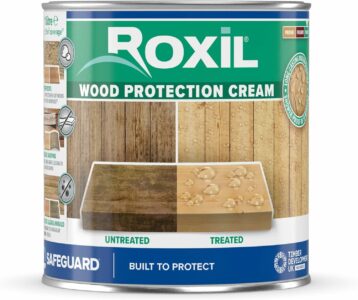
Roxil wood protection cream is an interesting product. When opened, it looks thick and white, but when you apply the cream with a brush, it soaks into the wood and turns clear. One user said it’s like applying anti-wrinkle cream to wood. The product uses silicone for waterproofing, and 3-iodo-2-propynyl butylcarbamate as an anti-fungal and mold inhibitor. The product does not change the wood’s appearance, neither refreshing nor altering its color. All users have raved about this product, and the manufacturer claims you’ll get ten years of weatherproofing for softwoods and weathered hardwoods. One point to note is that 3-iodo-2-propynyl butylcarbamate is widely used in paints, but it is known to cause allergies, specifically contact dermatitis. If you use this product, wear the appropriate safety equipment. It takes 24 hours to dry properly.
Pros
- Easy to apply
- Single coat only required
- Reduces warping and cracking
- Odorless
Cons
- Contains a biocide – always read the instructions before use
- Might cause allergies
- Uses mineral spirit to clean up
Thompson’s WaterSeal Waterproofing Wood Protector
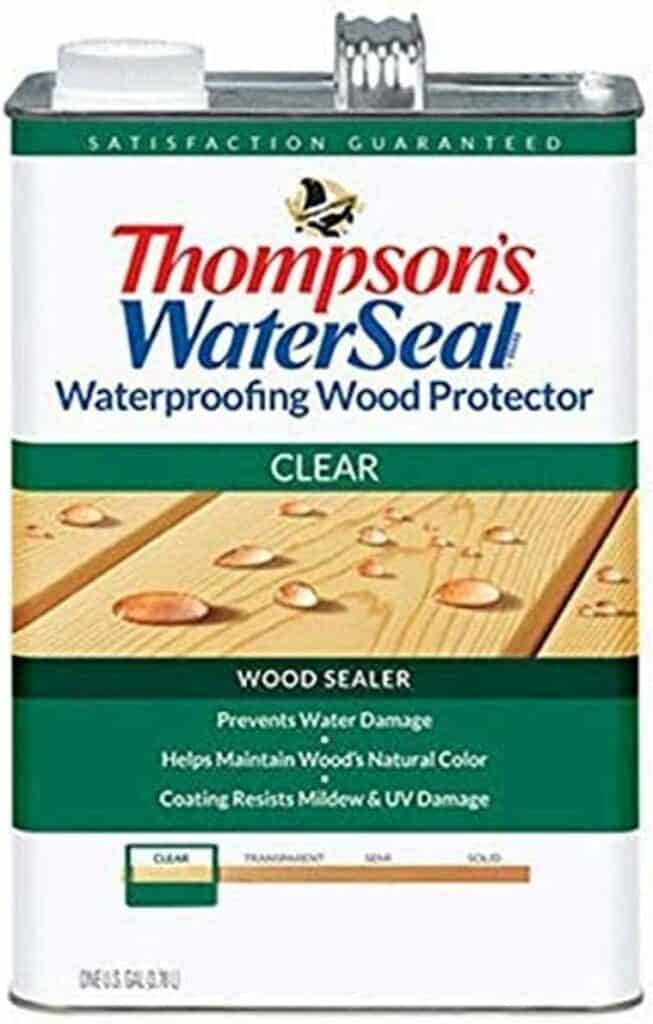
Thompson’s WaterSeal is a premium wood sealer. You can buy it in a transparent form or with a stain included to penetrate the wood and add color before creating a barrier against moisture. It offers a range of transparencies from clear through to solid color, and you can choose from several different colors. The product contains polymers combined with UV protectors to provide protection for outdoor wood while resisting fading. Use soapy water for cleanup, and allow the painted surface to dry for two to four hours before recoating or light foot traffic, depending on the ambient temperature.
Pros
- Highly regarded and well-known manufacturer
- Available in ready-mixed colors and clear
- Water-based for easy cleanup
- Added UV protection from the colored product
Cons
Some users report the stain color does not reflect marketing photos
Olympic Stain Smartguard Concentrated Multi-Surface Sealant
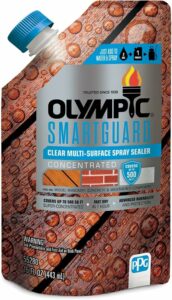
When you first view this product, your eyes might water at the price for such a small pouch until you realize it’s a concentrate, requiring you to add it to two gallons of water. Once that happens, the price seems a lot more reasonable. It’s another product that is absorbed into the wood and normally applied using a garden sprayer. According to the manufacturer, when the pouch is mixed, you’ll cover approximately 500 square feet, although I’m guessing that depends on your spray technique. It can be applied to damp wood, and you can use the surface one hour after application. Like many other products, it contains siloxanes and silicones, which provide the required water protection. Be careful when using this product, as it contains isothiazolinones, which may cause allergic reactions.
Pros
- Competitive price
- You can apply it over damp wood
- Doesn’t change the underlying wood color
- Quick-drying
Cons
- May potentially cause an allergic reaction
- Requires mixing with water
ZAR Polyurethane
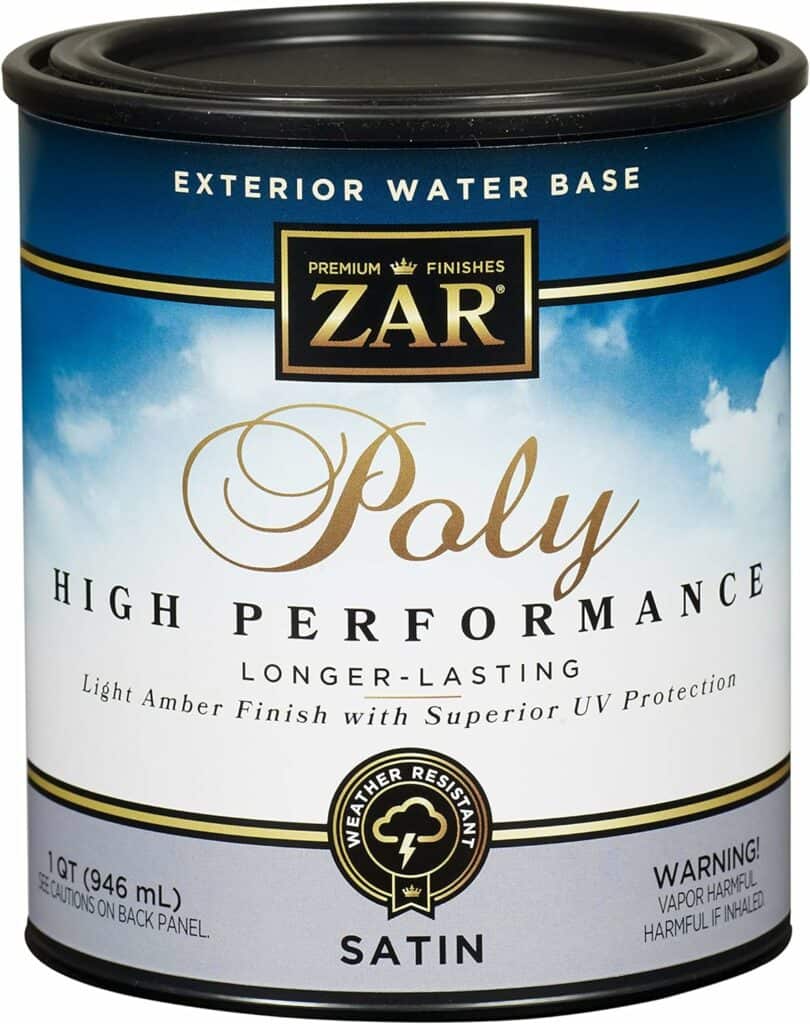
Polyurethane works by creating a flexible, water-resistant coating on the surface of wood. These days, you can buy water-based and oil-based polyurethane, with a big push by the industry to get everyone using the water-based product. While water-based is good, it isn’t quite as durable as oil-based, although it’s getting there. It’s also usually more expensive, but this product by ZAR is competitively priced. The benefits are that this product is touch dry in 30 minutes, ready for recoat in 2 hours, and available for maximum use in 24 hours. The manufacturer claims that this product gives maximum UV protection and long-lasting water resistance. It dries to a rich amber color.
Pros
- Cheap
- Easy to apply
- Lasts a long time
- Deepens the color of wood
Cons
- Not for flooring
Defy Marine Seal Wood Dock Stain & Sealer

This product by Defy is one of the few products we reviewed that is recommended for decks, particularly marine docks, so you’ve got to think it has good protection. It comprises a zinc nano-sealer, acrylic resins, and the option of four stain colors. The application should use a nylon or polyester brush, a sprayer, or a roller. It’s important not to overapply this product; simply apply two light coats that the wood can absorb. If the wood is hard and dense, use one coat. Dry time varies from 2 to 6 hours depending on temperature, and you should allow 20 minutes between coats.
Pros
- Premium pricing
- Easy application by brush, roller, or spray
- Rapid drying
- UV resistant
Cons
It can only be used on dry surfaces
Applying Wood Sealer for Best Results
Regardless of the product, the preparation for application is much the same. While you should always follow the manufacturer’s instructions, here are the steps that usually apply.
- If you apply the product to new wood, sand using sandpaper no finer than 220-grit. Do not use steel wool. Vacuum the sanding dust.
- If there are old finishes but in good condition, remove all traces of wax, grease, and dirt. You can use denatured alcohol and water, bleach and water, or simply warm soapy water. Once dry, sand lightly in the direction of the grain to remove any sheen and to provide a keying surface. Vacuum any dust.
- If there are clear finishes in poor condition, remove them completely, sand, and vacuum the dust.
- Ensure the surface is completely dry before application.
- Stir the product thoroughly but gently, being careful not to shake it.
- Refer to the manufacturer’s instructions regarding the correct applicator; some products require synthetic brushes, and others natural bristle brushes.
- Apply the product in thin coats in the direction of the grain, being careful not to overbrush. Observe the recommended recoat times. Most products will need 2 to 3 coats for maximum protection.
- Be aware of the cure time for those products containing drying oils or oil-based polyurethanes. Until that time is past, be moderate in your use of the surface. Once cured, the maximum traffic can be applied.
Frequently Asked Questions
Yes, Oils are suitable for waterproofing wood. Using a paintbrush, apply an oil finish to the wood, such as linseed oil or tung oil. Allow the oil to absorb and dry overnight before inspecting the coat. Apply a second (or even third) layer, if the depth of the oil finish isn’t to your liking. Allow two or three days for it to cure.
Yes, you can seal wood naturally by using 100% all-natural Tung oil or 100% all-natural linseed oil. They will take 2-4 days to completely dry and might need multiple applications for protection against moistures.
Yes, you can paint sealed wood. However, you must first prepare it properly. There are a few options for preparing sealed wood for fresh paint, but we like to use an oil-based primer. On sealed wood, the oil-based primer will adhere without any problems. After that, you may use latex paint to cover it up. All things considered, it’s a really simple procedure.
New wood needs to be sanded to encourage the opening of the pores. If the wood was previously finished and you want to rejuvenate it, you’ll need to sand it down before applying the sealant. Before applying a sealer, all old wax or oils must be removed (even oils from the hands), and the surface must be sanded until it is completely dull with fine sandpaper. This will give the new sealer a good hold and prevent it from peeling off.
The short answer: No, sealing wood will not make it completely waterproof. The long answer: Yes, sealing wood can make it entirely waterproof, but it takes numerous applications of sealer to make it entirely waterproof. The sanding and recoating procedure requires a great deal of patience and attention to detail.
Varnish is a great sealer for making wood coasters waterproof. When compared to other finishing solutions, it has a high solids ratio. Spar varnish can be used to protect the coasters from scratches, as well as to waterproof them. You can also consider using Polyurethane, which has both water or oil-base. Oil-based polyurethanes are more durable, but they can also give a slight tint to the look of the coasters. Polyurethane coats can protect coasters from heat, which is especially useful if you use them to hold coffee or other hot drinks. One downside of polyurethane is it takes a long time to cure.
The life of a seal on wood depends on different factors like the type of sealant, environment, no of coats, preparation before application. When all things considered well-done and in an ideal conditions seal should last 2 to 3 years.
Nothing lasts forever, and a wood sealer is no exception. It is generally recommended that you re-seal your deck every 1-3 years. Of course, that’s a big range, so you should think about your conditions and materials when choosing a re-sealing schedule. Obviously, areas with more rainwater and harsher weather conditions will cause sealers to deteriorate more quickly.
The usual way to apply a wood sealer is to use a brush. You should use a soft brush and spread it onto the surface, just as you would do with paint. It is recommended to use fast, brisk strokes because this stuff usually dries pretty quickly. Before you get started, it is important that you give your deck a good washing. Any dirt or debris that might be present will prevent the sealer from adhering to that spot. Thus, there will be a weak point in your deck’s protective armor. It’s also important to protect adjacent areas from any potential overspray.
In many cases, you will need to do some basic restoration before you can apply your wood sealer. If the deck is damaged in any way, a sealer will only trap the problem inside. First, go over the surface of the deck and drive any raised nails that you might see. As wood swells and contracts, it pushes the nails upward. That creates snags and will ruin the nice flat surface that you need. Use a hammer and punch so that you don’t have to strike the surface of the wood.
It will also be necessary to remove any remnants of the previous finish. These little bits of peeling paint will keep your sealer from doing its job, so all of it has to go. This can most easily be done using a pressure washer. If that doesn’t take care of the problem, your next step should be to apply a deck cleaning solution. If this is done, be sure to wet the grass and plants around your deck thoroughly. That way, any runoff will be diluted and made weaker. If you don’t do this, it’s very easy to kill your grass.
Polyurethane is fully inert and safe for people. Although the polyurethane finish is harmless once it has dried and cured, the finish emits potentially dangerous compounds into the air throughout the drying and curing process, a process known as off-gassing. It is not advised to sleeping in a house with uncured polyurethane.
Yes, we can seal wood without darkening it by using a water-based polyurethane sealer. Water-based polyurethane goes on clear, dries faster, and has almost no odor. Using a tiny brush, foam pad, or cloth, apply a very thin coat of polyurethane. To prevent raising the grain, work with it and don’t use too much polyurethane. After the first application has dried for a couple of hours, you may add a second coat.
The result of Brush or spray can be comparable if you take time with brush strokes. You don’t have to worry about brush strokes or fibers from the brush getting into the finish when you use spray polyurethane. Sprays require a good technique to avoid drips and extra prep time to protect surfaces from overspray. It’s important to apply the polyurethane in thin layers that dry fast and don’t leave visible start and stop lines. I would suggest using what you are comfortable with, both methods have pros and cons. If you are applying Polyurethane for the first time my suggestion would be to use brush because it is beginner friendly compared to spray. Polyurethane that has not been properly cured might cause breathing issues and should be handled with care.
Wood sealer is a plastic-based product that is used to coat wooden surfaces. This protects them from moisture and creates a smooth, transparent surface. Sealers work by penetrating the pores of the wood. When the sealant hardens, it hardens the entire surface of the wood at the same time.
Polyurethane is essentially a plastic that is liquid until it cures, is available in both water and oil-based versions, and comes in several finishes ranging from satin to glossy. Because of its low toxicity and minimal odor, water-based polyurethane is popular. It goes on clear and dries considerably faster than oil-based alternatives, plus it doesn’t add any color. Water-based polyurethane is susceptible to heat and chemicals. It’s ideal for bookcases, desktops, and picture frames that won’t be subjected to high temperatures. Oil-based polyurethane is more durable than water-based polyurethane, especially when it comes to heat resistance, therefore it’s a smart choice for a kitchen table. Although polyurethane is frequently confused with being different then wood sealer, it is actually a form of sealer.
Rather than applying the sealer with a brush, some people choose to use a garden sprayer as a way to deliver the sealant to its target.
You don’t want to try a paint gun because a sealant will clog the tip very quickly. A garden sprayer may also get clogged from time to time, but they are a little easier to clean. If you go with this option, I would recommend that you use a brush for the railings. The garden sprayer should work fine for the deck surface, but using it on the railings will just cause too much overspray.
In some cases, you can find products that function as both stains and sealers. However, most people choose to use them separately. Staining and sealing are two completely different jobs that are done for completely different purposes. Stains are used to change the appearance of the deck by changing the color (or at least the shade). Sealers are generally transparent, so they don’t change the color of the wood. They do provide a nice shine, but sealers are meant to be functional rather than decorative.
Some of the best ways to waterproof wood are: Using Oil to Waterproof Wood: Oil works best as a waterproofing solution for minor projects like treating a table or countertop. Oils are easy to apply and will protect against moisture. Tung oil and Linseed oil are the basis of modern hand-rubbed oils. Its protective characteristics aren’t as long-lasting as varnishes, but it’s popular for bringing out the character of wood with a pleasantly contrasting shine over the grain. Using Sealant to Waterproof Wood: Sealant can prevent scratches and abrasions on tabletops. As well as waterproofing the wood, it can also prevent wooden surfaces from getting scratched. They are often a clear/transparent finish that coats the wood’s exterior surface. Sealants such as polyurethane, varnish, and lacquer give excellent waterproofing. They’re brushed or sprayed over sanded, clean wood, then softly re-sanded and re-coated when they’ve dried fully. They offer high moisture resistance compared to the oil finish. Using Epoxy to Waterproof Wood: Epoxy can be used to give wood a waterproof and durable coating. It’s a good choice for wood projects that will be exposed to water in most circumstances. However, in some circumstances, utilizing epoxy as a finish is not recommended; however, you can still get the benefits of epoxy by using it as a sealer before applying your finish layer. While using epoxy to seal your project will take a little longer, the extra effort will pay off in the form of an enhanced lifetime and fewer maintenance costs.
It is a good rule of thumb to go for Heartwood while shopping for wood. Heartwood, also known as duramen, is the dead center of a tree. Its cells typically include tannins or other chemicals that give it a dark color and, in certain cases, a fragrant scent. Here are some of the wood types that excel in resisting rot: Mahogany Mahogany’s great density and hardness make it extremely resistant to water and insects. It is noted for its great strength, stability, and longevity and is one of the most resistant wood to rot. It has a delicate, visible grain that sometimes spirals. Colors can be anything from gray to brown to red to orange, or a mixture of all four. The majority of Mahogany wood used in the United States comes from three countries: Mexico, Honduras, and the Philippines. Teak Teak has been dubbed the “gold standard” in terms of decay resistance. It’s also extremely long-lasting and termite-resistant. It is highly valued for its look and durability, but it is also fairly costly. Widely grown in Africa, Asia, and Latin America. It seems to be golden to medium brown in hue, with the color deepening over time. The grain is usually straight, though it can be wavy on occasion. Black Cherry This wood is native to Eastern North America and is known for its durability and resistance to rot. It is reasonably priced wood. It is pinkish brown when freshly cut and darkens to a medium reddish brown with time and exposure to light. Except for a few curled grain patterns, the grain is usually straight and easy to work with. It has a smooth, consistent texture.
The primary reason for sealing wood is to keep moisture out. If wood is left exposed to the elements without being sealed, it will rot. Water intrusion into wood can result in more than just fungal growth and decay. If wood freezes after absorbing water, it might crack. Water isn’t the only danger to your wood. UV rays from the sun can cause colors to fade and turn gray, and also cause wood to crack and split. One of the advantages of using a sealer on your woodworking projects is that it adds an extra layer of protection. It will hold its shape considerably better in the face of changes in the environment.
Conclusion
All the products we’ve reviewed are great at what they do, but only you, as the consumer, know your specific application and aesthetic. I hope the information we’ve given helps you decide what features you need in an exterior wood sealer and allows you to make a selection appropriate to your budget, climate, and the look you want.
Its recommended to check our questions page for further consultatio). I hope that we have given you a good start on this process and that you will come back again for more of our honest advice. You can always ask us a question directly, or comment below.











Good review of the different sealers – i am a technical rep for wood finishes and just wanted to add that there is one major difference between water based and oil based wood finishes – water based finishes dry to a porous coating(moisture vapor will still move in and out of the wood, slowly from humidity) – while oil based finishes seal the water vapor out(humidity will only move through uncoated areas of the wood). This is due to the chemical process of drying water vs oil/alkyd solvents…and causes confusion about what “sealed” means, they both seal out liquid water, but only oil seals the vapor also
Think of water based finish as tyvek(porous), and oil based as tar paper(non-porous) – my own opinion, from tracking many jobs over 25+ years, is that the manufacturers keep trying to make a water based wood finish perform as good as oil can, but haven’t got there yet – and may never, due to chemical differences
example – cabinet/furniture finishes are still high VOC oil/alcohol spray laquer that last a lifetime
Thank you for that information; it’s a great insight into the chemical differences and teaches me something while being useful to the readers. As I’m a bit old-fashioned, I must admit a bias toward oil-based, although I’m trying to open my mind a little.
We are repairing a wall in a kitchen above a door where there was a water leak. We would like to treat the 2×4 framing with a wood protector – kill any existing fungus/mold and protect future dry rot – before we sheetrock. Do you have a recommendation on the best treatment for interior framing that will not have the odors of something like Copper Green?
Hi Kevin,
A borate treatment sounds the best for your use, I suggest this product. Soak the wood with it and allow it to dry before sheeting up the area.
The borate soaks into the timber preventing any further mold growth. Just be sure you’ve solved the original water leak, as the borate can be washed out again if the leak continues.
Lots of good information! Still confused..putting up a Cedar outdoor pergola kit in Ga. What kind of sealer would you recommend? It gets 90-100 degrees here in the summer and down to mid 30’s during winter [infrequent]. Thanks for your insight!
Hello Zane,
For your weather conditions you can use this product by Rainguard.
It protects the surface against water, snow, and ice. Advanced UV stabilizers are incorporated to ensure long-term non-yellowing performance without changing the look of the surface.
Hi William, what would you recommend to seal/protect a laminated wood outdoor stair riser in Montana. The wood that decorates the ceiling & walls of the covered deck are Blue pine & we used Tung Oil & love the look. We did the work ourselves so we know that Tung Oil takes several coats etc. The laminates used for the stair risers were already used outside for another purpose and we purchased them second hand because they were perfect for what we wanted. We have since sanded down the weathered outside & cut them to be the stair risers but we need to seal them. We love the laminate look & don’t want to hide it. They are 5 inches wide by 18 inches deep. 2 sets of stairs so lengths vary. Should we use the Tung oil or use something else?
Hello Kim,
You can use polyurethane to seal your laminated wood. Polyurethane is High abrasion-resistant, can bear Superior load, UV, and water-resistant. You can use the following product by Rust Oleum.
I have a cedar deck put in last fall, what is best clear sealer and I live in Minnesota
Hello Nam, you can use this product by Rainguard.
It prevents surface damage from rain, snow, and ice. It doesn’t change the appearance of the surface, it also has advanced UV stabilizers to provide long-term non-yellowing performance.
Hello William,
Thank you for the informative article! I am going to seal the cedar deck and wondered what is the best option to go with. The wood is pressure-treated cedar and the condition is good. There are some cracks but nothing serious. The wood has not been painted before. Our area receives a lot of rain throughout the year and it would be nice to find a sealer+stain solution that would last a few years. I am in Canada and we have Thompson, Behr, Olympic and Sico brands for stained sealers. The reason why I look for a stained sealer is because some wood is discolored (gray color) while other parts are naturally yellow.
I would appreciate your help,
Owen
Hello Owen,
I would recommend this stain by SaverSystems.
It prevents water damage, resists mildew and UV damage. You can apply it to freshly cleaned damp or dry wood. It can be used on pressure-treated cedar.
Hi, William…
I am very happy to have found you as an informed resource for wood sealers. Many thanks for your input and suggestions.
I have been working on a problem/project for over 15 years at my home church, Calvary Baptist Church in Denver, Colorado. I was recruited for this project because I was the only architect in the congregation. We have an outdoor courtyard where we have placed our columbarium, a repository for cremains (ashes) for people from the church who have passed.
Above the columbarium, we have a pergola. The pergola consists of exposed portions of the original wood framing for what used to be a mansard roof, to which we have added some 2x10s as horizontal extensions (I would be happy to share some photos or drawings, if I can figure out a way to do that). The wood framing from the original church construction (ca. 1959) was trusses made from common wood framing materials, although I do not know the exact species. The 2×10 horizontal members we added were also common wood framing members, I believe Douglas fir.
All of the wood members were initially stained with a solid color stain 16 years ago. I do not know what that product or manufacturer was. Over time, that original coating has deteriorated, as the pergola has a southern exposure to the sometimes brutal Colorado sun. At a time when I was living in Oregon, the columbarium volunteer staff hired a young member of the church to prepare and re-coat the pergola wood. Regrettably, he did not know how to prepare the surface, or how to apply new stain. I do not know what stain he used, but it did not hold up at all. By this time, I had moved back to Colorado, and was re-recruited to help address this problem.
I met with the local architectural rep for Benjamin Moore Paints to examine our pergola and make recommendations for remediation. Since the wood was crazed and cracked, and the coating was peeling, we agreed on scraping and sanding to get back to bare wood as much as we could, and then (as I recall) priming with B-M primer for solid color stain, and re-coating with B-M Arborcoat. Decaying wood was filled with a filler recommended by our painter. That work was completed two summers ago.
Now, just this short time later, the Arborcoat has failed and we need to re-prepare and re-coat once again. I am very disappointed in the Arborcoat, as I was of the impression that it would require only minor touch-up for at least several years. Since that did not turn out to be true, we are now searching for a different product that will stand up to the weather conditions better than the Arborcoat. That is what has led us to you.
I would very much like to know what you think about our pergola, and what product(s)/procedures you would recommend. I sincerely hope that you have some time to work with us on this problem, as we are a bit uncertain about who else to ask. If you can recommend someone, I would welcome that. Many thanks in advance. If you would like photos, or to discuss this further, I can be reached at the e-mail address or phone number below.
Larry Jenks
Hello Larry,
If the wood is cracked and is in poor condition you need to fill those gaps and seal them remember to clean the cracks and remove any residual paint from cracks before filling them.
Sand entire pergola after repairing of cracked wood is completed. a pergola was out in the weather, there is a good chance that many of the wood fibers at the surface became weathered and were no longer well-attached to the underlying wood, weathered wood should be sanded to get rid of the gray fibers before it’s painted.
I think something like this product by Rust Oleum will work well but your mileage may vary.
Please help me!! I’ve been reading so many sites I’m getting confused. I’m building a feral cat house and need to seal/waterproof it. So I need an outdoor, non toxic will work on plywood and last at least 3-4 yrs. Can you help me?
Hello Stacy,
There are many non-toxic ways to make plywood waterproof. For a feral cat house, using epoxy sealant would be the best method.
Epoxy is quite strong and can be used on plywood that has to combat harsh conditions outdoors.
The main advantage of epoxy is it protects the wood while allowing it to retain its natural color, it forms a hard and durable layer that is stronger than paint. Unlike paint, it can be reapplied without having to remove the older layer of epoxy.
You can use epoxy like this one by Max GPE. You just need to sand the surface to remove any dirt, debris, and loose particles. Then, apply the epoxy sealant.
Apply the epoxy in an even layer while it is still in a liquid state. Epoxy will dry pretty quickly once it comes into contact with a dry surface.
I am using ash cladding in a bathroom. What products would you recommend for water proofing? The wood will be in a high moisture area but not in direct contact with water excepts for some droplets, mist and occasional splash.
Hi Bruce.
This sealant is suitable for indoor and outdoor use and has excellent water protection. Besides, it will have a long life.
Another option is boiled linseed oil, it is a natural product, gives a more natural look to the wood, and has very good resistance to moisture. You will need to apply more often than the sealant.
I have a wooden lattice plant stand that will be manly in the house.What kind of water seal would you recommend?
Hi Eileen,
This sealant by Rain Guard will do a great job for you. It is suitable for indoor use and has very good water resistance.
Apply according to the manufacturer’s instructions and you will have long-lasting protection.
At the first sign of wear, simply apply another coat to keep the wooden grille for a long time.
hi William, i have in the past 50 years been collecting drift and other unique woods from the rivers and streams and mountains of Colorado and New Mexico. Now I am going to put these pieces together to make a waterfall/fountain. So Thanks for the wealth of your experiences with goods of the woods. I need the best sealer for submersible, soft woods that will repel molds, prevent deterioration, after dry outs. I am not worried about the color, of the evenness of the coating. But I do need something that would not change the color of the grey weathered wood. Can you advise me of the best sealant/protectant/tough finish for such a project. Thank you for your expertise.
Hi Will, you have a really interesting project 🙂
If the wood is too soft you can check out this article, the wood hardener gives additional protection and strengthens the wood.
Then you can apply a sealant like this one by Rainguard which has excellent water resistance and long life. Remember to dilute before use.
At the first signs of wear, repeat the coating.
About 8 years ago, I replaced some railway ties for retaining wall in my garden and around the window well. I was told that they were treated I would not have to apply anything but about 5 years ago, I noticed. that some of them are starting to dry and crack. I used a wood sealant and repeated treatment 2 years later. What would you recommend as a good water protectant and sealant? How often do I need to reapply?
Hi Betty.
This seal by Rainguard should work.
It has excellent waterproofing, protects against mold and mildew, and has a long life.
Apply when you notice the first signs of wear on the coating. It is difficult to say how long the coating will last, it depends on many factors but mostly on how harsh the weather conditions are.
I think the sealant will last at least 2 years or more.
I recently purchased a house that the deck had been painted. Maybe a few years ago, so it was in need of another coat. I repainted with an exterior high gloss paint, after caulking a few bad places, wondering what kind of sealant I can use over the paint. This was s lot of work, as its 16’x17’, and I don’t want to do it again anytime soon. What sealer can give me extra longevity? Thanks
Hi Dawn, this sealant by Rainguard will be suitable for you.
It blends well with the paint, does not turn yellow, and has a 5-year warranty. Don’t forget to dilute before use!
If the paint is already well dried, it is good to sand a little with P220 before applying the sealant and to be sure that it will adhere well.
Hi I have used several types of stain and oil on my decking but nothing seems ok. I have three dogs who wee on the decking so need to know what to use first an oil or a sealer . The decking has been pressure washed and is now back to basic . Now I want to coat it But where to start? Thanks
Hi Jaqui.
Our pets give us a lot of joy but they also want care.
The sealant will give you more strength on the deck surface. Make sure that you remove the oil, sand the surface, if necessary, fill the holes, and other imperfections with filler.
Once you have prepared the wood you can apply sealant. If you want to apply color you can use a stain and sealant in one like this product by Thompson’s, it will give you good strength.
For even more protection you can use a transparent sealant on top by Thompson’s: apply a new coating as soon as you notice the first signs of wear. This way you will keep the deck and the upgrade will be easier.
We have a cedar screen door which we applied 2 coats of cedar-seal two years ago. The outside is now grey and doesn’t looks bad, It faces east so it’s in the sun most of the morning. Looking to possibly stain then seal it to keep it from turning grey again. What is the best way to get the old Cedar-seal off so it can be stained, also can I use Australian timber oil to stain then seal with Cedar-seal? We live in Wisconsin so it needs to stand up to cold weather and lots of snow. Thank you.
Hi Michelle.
To remove the old under cover you can use a detergent to remove old paint, you can try this one by Dumond.
I recommend it if you have a thick layer of coating; if the coating is thinned by the sun you can use a sanding disc to remove paint like this one by 3M and sandpaper.
The stages are detergent, disk, sandpaper. If the layer is thin, you just skip the preparation.
For coloring you can use this great product by Thompson. In addition, for extra protection to cover the top with this sealer by Thompson.
I’m not sure that Australian oil and cedar sealant are compatible, it’s good to use products on the same basis and, if possible, the same brand to ensure a good bond between the layers.
Hi, I’m reposting as my original did not seem to go through. I’m building a custom horse barn and had the builder make pine barn end doors. The doors Dave northeast and I’m in east Colorado with sun, wind, and snow/rain
I would like a medium brown stain and the best possible finish so I do t have to sand and redo annually. Also don’t want warping! What do you suggest?
Hi Kim, excuse me for the late answer.
The answer to the original post you can see above.
In short, you can use a stain with a Thompson sealant and for maximum protection to apply a transparent sealant on top this way you will have a thicker coating that will last longer.
However, know that the door must be well pre-treated, support in a few years is inevitable.
Hi, I’m building a barn and have double barn end doors faced on the exterior with pine. They are northwest facing but will get a morning and afternoon sun, as well as wind and rain/snow. I’m east of Denver, CO. I would like to stain and seal(?). Should I use a marine type sealer? Can you suggest a product and compatible stain? Thx!
Hi Kim,
Wood seals are designed for outdoor wood such as decks and furniture, so in your case, they will do a great job.
The decks are usually subjected to harsher conditions and the seals hold well. To make sure that the stain and the sealant are compatible, it is always good to use products on the same type of base (eg water) and preferably from the same brand.
You can use Thomson’s seals all in one so you can get a stain and a sealant in one.
After choosing a color, you can apply more than one layer for a darker shade.
Once you have the color you want, you can update the coating with a clear sealant like this one by Thompson.
You can also apply it to the color sealant for extra protection.
So, the concrete on my little back patio, that was put in back in the 60s, had finally gotten to the point of no repair. Instead of busting it out and spending a crap-ton of money on a new slab, I put together a little deck made from pallet wood. It’s roughly an 8x10ft space and the wood is a 3/4in yellow pine. I’m at a loss to decide what product to choose, any recommendations you have would be a blessing.
Hi John,
You have made a smart decision for your board, you have saved a lot of money and the wood will be more pleasant in appearance and touch.
The disadvantage of wood is that it is difficult to withstand atmospheric influences and therefore we must protect it and maintain it when necessary.
In your case you can use the top product from the article by Thompson one bottle will be enough for you and you will be able to finish the task in one day. This sealant is suitable for both pressure wood treatment and new wood as in your case.
Remember that timely maintenance is as much a factor as your choice of product to keep the wood.
If you want to apply color to the wood you can use a sealant with color or if you want a solid color paint you can look at this article.
Am still sceptIcal. What is a true CLEAR oil base wood sealer? The last two that I used left a yellow tinge and only lasted (before gray set in) one year.
Hi Keith,
I understand your skepticism, manufacturers usually say durability under ideal conditions (similar to the fuel consumption of cars) but in life, there are no ideal conditions, and the coatings have a shorter life.
Water-based coatings are less prone to yellowing (unlike Polyurethane and oil-based coatings). Yellowing is usually due to UV rays so the coating should have good UV protection (this will also help the life of the coating).
This product by Defy has the potential for longer life and color retention.
However, there is no way not to maintain over time and this can be done relatively easily (cleaning the dirt and applying another layer.
If you still prefer to avoid this type of sealant you can use polyurethane varnish for water-based exteriors like this one by Rust-Oleum, customers claim it will not turn yellow over time.
Hi, I have never done any wood work before, but I inherited an wood outdoor bench and would really appreciate your advice. I have no idea what wood the bench is made of, but I suspect that is was previously stained and varnished. The bench was outside for over 10 years with no maintenance and was flaking and the wood underneath was becoming discoulored. I have stripped off the old varnish (which took many coats on the detail areas), have sanded down the wood and am now getting ready to stain and protect the bench. It will live outdoors year round in the Pacific Northwest (rain!), and I really don’t want to have to do anything to the bench for years to come as this has been a lot of work. Based on your responses to the comments above it looks like you’d recommend the Rust-oleum marine spar varnish after the stain. I this correct, or do you have an other suggestion for this situation. thanks again for your help
Hi Michelle, in your case, the work of renovating the bench was too much because the bench was not maintained for a long time.
Atmospheric conditions are a severe test for any coating, over time the coating thins and disappears. No matter what coating you use, it is good to apply a new coating at the first signs that the coating is damaged. This way your work on the upgrade will be 10 times easier, just a little sandpaper, and apply with a brush.
Rust-oleum marine spar varnish is a really good choice for your case, the coating is very resistant to water and is plastic to absorb the natural shrinkage and expansion of the wood.
A few things you need to know – the varnish has a yellowish tinge (this is most noticeable on white paint and other light colors) and the coating is soft and may leave traces of hard objects.
Another option is wood oil outside Cabot 140.0003400.005 Australian Timber Oil, Quart, Natural
– the old varnish must be completely removed
– Easy to apply with a brush
– Easy to maintain, no need to sand before applying the next layer (after 1-2 years)
– The disadvantage is that it lasts about 2 years, after which it must be re-lubricated
It’s always important to understand that similar to wood, everything around us wants attention and support to make us happy for a long time 🙂
I used copper green brown on some 6×6 cedar fence posts. Can you reccomend an oil based sealer? Thank you.
This oil-based Spar urethane by Varathane is really good to help protect the wood.
Hi! I tried posting earlier, the page timed out & doesn’t look like it went through? I aplogize if it’s a duplicate.
I have no idea what I am doing & have been reading & rereading your reviews (which are great btw). I am still unsure about which product to use & the application. I just purchased a tabletop made from reclaimed wood, a mix of “spruce, pine, fir, etc.” that lists it as having a water based urethane matte finish. It said is not recommended for outdoor use. That is what I bought for, it will be outside year round under an open umbrella. I live in the NE, in terms of weather conditions. I figured I could just seal it and it would be ok? I don’t want to ruin the stain & texture by sanding the current finish off. Can I apply a sealer over this urethane and what product would you recommend & that will also provide UV & water protection? Thank you!
Hey Nikki, no worries :). Your previous comment was received properly and will be answered in the next 24 hours by a member of our team.
Hi, I have zero clue what I’m doing. I just purchased a reclaimed wood tabletop for an outdoor table under an umbrella, it’s usually always open. Listing says “mix of spruce, pine, fir, etc.”. It says it has a water based urethane matte finish & is not recommended for outdoor use. I figured I would just seal it and use it outdoors.
Can I apply a sealer over this urethane finish without sanding? I don’t want to ruin the look & stain. What product would be best to do so? Thanks!
You can apply a sealer over the previous finish but for the best results I would recommend sanding it first but it’s not necessary. I would suggest using a spar urethane by Minwax to seal the wood. If you decide to sand the wood and it ruins the look I would just try to find what color stain it was or try to find the best match to what is already on the wood. You can always lightly sand to get some of the urethane top coat off if you want.
Thank you very much! I couldn’t find anywhere if it was ok to do that. I appreciate it!
NP Nikki! always great to receive your feedback.
We just purchased an outdoor deck dining table made from acacia wood. We want to protect it from the rain/sun. What would you recommend treating/staining it with that would be low maintenance?
If you want to stain the wood, I would recommend using a stain by Minwax or Varathane. You can even use poly shades by Minwax that has a stain and polyurethane together. Polyurethaane will protect the wood but for even better protection since it is outside, I would suggest using spar urethane by Minwax or a marine spar varnish by Totalboat or Rust-Oleum.
My brother and I need to seal diy walnut board and batten siding for an enclosed front porch. The walnut was harvested off our farm and has been stacked with spacers for over ten years . One side will be planed. We live in the humid mountains of the Carolinas near Brevard, North Carolina….our average rainfall is 68″ a year.
Should I seal the ends of the boards with an end grain sealer? Because of the rainfall amount I thought about using Waterlox Marine sealer, but the Seal Once Exotic Premium Wood Sealer or Totalboat Marine Spar Varnish look promising. What would you suggest.
Thank your for your time and sharing of information.
Yes, I would suggest sealing the ends of the boards with an end-grain sealer. This isn’t necessary but it will help the wood over time. All of the products you listed are good products. Out of the three you listed, I would suggest using the Totalboat Marine Spar Varnish or the Seal once wood sealer.
Fabulous! What a great article and you really know your stuff. I have just spent a week trying to work out the best solution for my cedar external handrail. The difficulty is with some of the products, if you get it wrong you are goosed!
I have sanded off all the old product and the wood looks good but does need some colour so I will follow the instructions for the gates above. Thank you again.
Always great to see such great comments, Thx Linda. Send us pictures of the final products once you’re done 🙂
Hello,
We just purchased an outdoor dining table with an Arcadia wood top. It’s on a stone deck and we’ll have an umbrella up, but only when we’re using the table so it will be exposed to a lot of direct sunlight.
Can you recommend the best oil or treatment to help protect the table? It seems Tung or Linseed oil might be best but I was confused about some of the caveats with those options especially since it’s a dining table and we have young children.
Both of those oils will work, but since the table will be exposed to a lot of direct sunlight and you have children I would suggest using spar urethane by Minwax. The spar urethane will help protect your table from sunlight, water, and temperature changes.
Thompson’s water seal now has a new product teak oil .I don’t hear you mention it.I have a new pressure treated deck,what is your opinion on a sealer only?
The new Thompson’s teak oil is a good product. I would use teak oil on smaller projects, rather than a deck but it will still work. The teak oil will bring out the wood grain, protect from UV radiation and water stains. The only thing about teak oil on a deck is you would most likely have to reapply it over time more often than you would like. To keep your deck protected well over a longer period of time, I would suggest using a waterproof sealer by Thompson’s or by Defy.
Hi I enjoyed your articles but I am also confused as to where to start. I have old 60 year old gates that hung outside for 30 years and then were stored in my shed for 30 years. I have re hung them at my farm entrance on an electritonic gate opener. They need to be stained and sealed or varnished. It is not a project I want to do annually. What do you suggest??
Since you don’t want to redo this project annually, I would suggest using a stain by Defy or by SaverSysytems. To seal the wood, I would suggest a waterproof sealer by Thompson’s or a spar urethane by Minwax for even more protection over time.
I have an older White Mountain wooden electric ice cream maker. On the bottom of the wooden tub the glue like sealant is pealing away. I contacted the customer service department, but she was unable to recommend a solution. I found your website, and hope you have some suggestions. Thanks
I would recommend just stripping the sealer and reapplying a new one if wanted/needed. I would recommend this sealant stripper by OMNI on Amazon.
Thank you for the informative brush-up, William. Possibly related follow-up question that i’ll attempt to make short… Finished rapidly greying salvaged wood planks (unknown type) with basic floor poly and need a recommendation for a sealant that wont advance the greying of the wood if possible. Thanks much.
I would recommend a polycrylic sealant by Minwax or this spar urethane sealant by Minwax.
Hi: Your article was very informative; however, I still am alittle confused as to what to use. I have a cedar 10×12 gazebo. I recently discovered that I have carpenter bees!! Never heard of them but found that they are quite common. I have treated the carpenter bees but have been told that I should seal my gazebo because they don’t like the “smell of the sealer and therefore, wont come back. Which sealant do you recommend? I definitely don’t want the graying….the wood is a beautiful natural color. HELP!!
I would recommend a transparent sealer by Thompson’s or Behr.
Hi. I used Thompson’s water seal on a cedar porch swing. Do you know what I can do to either get rid of the oily feel or what I could paint over it with to stop the oily feel? Thanks much.
You can use dish soap and water to help remove the oily feel on the wood. Depending on how aggressively you scrub you might have to reapply the seal if necessary, but you should be good.
Removed paint from DF siding on 1920s home. What can i apply to condition or preserve wood before oil base primer?
I would suggest using this water seal by Thompon’s on Amazon to help preserve the wood before the primer, just make sure it is completely dry before putting on the primer.
WARNING – Thompson’s water seal in aerosol spray cans has been recalled by the manufacturer because the product reacts chemically with the metal can, which could result in the can rupturing spontaneously. Since the product is highly flammable, this could result in an explosion if it is stored near a fire source. See https://recall.thompsonswaterseal.com. Note that only the aerosol spray form of the product is impacted by the recall.
Hey Paul, and thanks for the heads up!
What’s your choice of sealer for a wood chicken coop? The description says the wood used is Fir. Thanks
Jamie
I would use a wood sealer by Thompson’s or Behr. Something like this from Amazon or any hardware store would work.
Wonderful post. Thank you!
I’m a woodworking noob. As a very simple starter project, I’m building my own desk by buying metal table legs and buying a kitchen countertop (https://www.homedepot.ca/product/interbuild-72-inch-x-25-5-inch-x-1-5-inch-acacia-wood-kitchen-countertop-unfinished-live-edge/1001123400).
The countertop is unfinished, and I need to finish it. What’s the best sealer to use to protect acacia wood for a home office desk?
Since it is a desk you shouldn’t need anything too fancy. A simple polyurethane topcoat should seal it well enough. I would recommend this Minwax polycrylic protective finish from Amazon. If you want ultimate protection for your desk from water and sunlight I would use a varnish such as spar varnish.
Very good review. I have a question regarding re-coating a pressure treated deck that is two years old that was originally coated with an oil based sealer (Thompson’s I believe). Can I use a water based sealer now over the original oil based sealer or must I always use oil based sealers?
Yes, you can use a water-based sealer over the oil-based sealer. It shouldn’t be a problem since the oil-based sealer has been on your deck for a while. It would only be a problem if the oil-based sealer wasn’t dry yet.
Yes, you should be able to color match the paint or get something very close to it. For the durability and waterproofing of the wood, I would use a wood sealer or spar varnish which can be found online or at any hardware store. Yes, the Kilz paint will work to repaint your deck as long as you make sure its exterior paint.
Hi! We just built a small deck around our hot tub and used a semi transparent sherwin williams deck stain. However we don’t feel that it water proofed the wood much. Can we put the Thompsons water proof clear over the stain we used? It was a water based stain and we put two coats.
Thanks
Hi,
Yes, you can. Sealers can be applied over stains.
Looking at Lowes website , the Thompsons bad reviews are horrible??
I have a new treated privacy fence put up today and the fence builder said to stay away from Thompson products? I went to the Lowes site and sure enough, the low reviews are bad, I’m confused on what to use.
Hi Randall,
Thanks for the comment. Thompsons may have changed its formula recently or something. I will check the comments and update this article accordingly. Try Rainguard instead.
Hello William, I want to know which sealers are suitable for dry wood?
Hi,
Actually any sealer on the list. Dryness isn’t an obstacle to seal the wood.
Got a summer house that’s letting in water through gaps. Is there any sealer you would recommend to help to seal the gaps and make it water proof
Hi Pete,
Wood sealers seal wood pores on the surface making the wood waterproof. But sealers don’t fill holes and gaps. You have to look for wood fillers.
Hi William,
If you were to seal or oil a spotted gum deck what product would you chose or recommend?
Cheers Justin
Hi Justin.
I recommend Thompson’s Advanced, it’s just perfect for decks. It’s better you clean your decks with deck cleaner before sealing.
I have an exterior bar that I just built. It has a burnt wood finish that I would like to keep its look. What kind of sealer or polyurethane would you recommend. I would like a non yellowing clear finish that doesn’t have to be applied every year
Hi Harold.
I think RainGuard is a perfect choice here. It’s longlasting and eco-friendly.
I have a question, I removed the varnish, stain from kitchen cabinets and like the color of the natural wood, I was told they are birch . I do not want to stain them so what do I put on them to protect them. Do not want too much shine on them. First time doing this, how far down do I sand can I go too far? Thank you
Hi Dab.
You may use durable transparent polyurethane which doesn’t affect the color of the wood. General Finishes Topcoat is a winner here. Choose a matte finish.
Hey Guy,
I have just finished 2x spotted gum decks, I’m chasing a sealer that doesn’t not change the colour of the timber. Is it possible to get a sealer/oil that makes the deck look wet all year round? and bring the massive colour variations out in the timber. what would be the best product to help achieve this results?
Cheers Justin.
Hi Justin.
I think it’s kind of tricky to get all of that. Sealers tend to yellow the wood, as well as oils.
Hi – what would you recommend for a wooden playhouse? thanks!!
Hi Ann.
Definitely, playhouse sealer needs to be environmentally safe. For you I would recommend Rainguard which is non-toxic sealer, good choice for children safety.
Hi there,
Thanks for the article, good information.
We’re building a new cedar fence and looking for weather protection to extent the look and life of the wood. The Agri Life Cedar-Seal sounds great as we will have fruit plants growing next to the fence, so non-toxic is pretty important. However, since there will be plants, it won’t be easy to sand and reapply the seal. The con, “Fades faster than comparable products,” is worrying me a bit. Would you still recommend the Cedar-Seal or one of the other sealers?
Hi Man Y Li,
There is also the Rainguard Concentrate Premium Wood Sealer. It’s a great eco-friendly option. But for you, I think Agra-Life would be better since it’s designed especially for cedar even though it may fade faster (because people don’t read the instructions). Anyway, cedar needs reapplying every 1-2 years for it dents to grey by itself, sealer slows this process. You may try Agra-Life, if you don’t like the results reseal using a different product in one year. But I think everything will be ok.
For exterior of porch with mahogany structure and screen frames (all vertical surfaces) 300 yds from salt water bay, plenty of sun and rain I’d like these characteristics: A. 1 coat application with minimal prep and pretty easy re-application in subsequent yrs; B. Won’t darken mahogany much or at all; C. Controls mildew; D. Some greying of wood ok.
We just sanded all surfaces after another product that we weren’t happy with after 2 yrs, so now we’re ready for a new better approach.
What are your recommendations?
Hi, Erin.
I think spar varnish is the best option for you. Varnishes are like sealers, they provide great protection against the sun, moisture, mildew and salt water: they can be used for boat finishing. Try Totalboat Marine Spar Varnish. Don’t worry, spar varnishes can be used for all exterior wood, not only boats. Totalboat meets all your requirements except that it needs 1-2 coats.
thanks for your article. i have an unusual problem. i have a large exterior dome (7 metres or 23 feet in diameter, and 11.5 feet high) made of marine ply or possibly simply plywood (5 ply).
the dome structure has 2 skins (= 4 surfaces). in addition, endgrains are exposed where circles are cut out of the main surfaces..
it needs to be protected against subtropical rain and sun. (I am in Australia)
and because it is so large and complex, i need the protective surface to last for at least 5 years, i cant contemplate re-doing it more often.
can you suggest what to use to protect from it rain and sun please?
Hi, Margrette.
Basically, there are 2 types of exterior protective finishes: sealers and varnishes. Varnishes are denser so they don’t penetrate into the wood. Instead of that, they form a protective coat on a surface that protects against the water and sun but will peel and crack without annual maintenance. On the other hand, we have sealers that aren’t so dense as varnishes so they do penetrate into the wood, it’s better to apply several coats (2-3) of sealer to form many protective layers. Sealers last longer than varnishes, they may stay for 3-10 years. So, in your case, I would use a sealer, namely Thompsons WaterSeal Advanced Natural Wood Protector (top1). Several coats should do the trick.